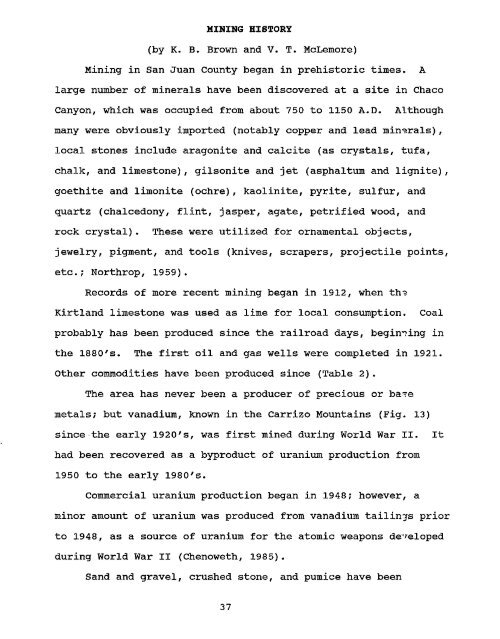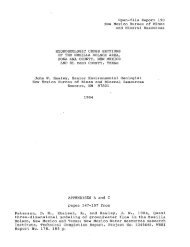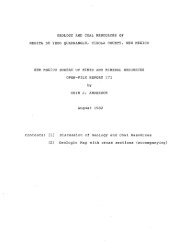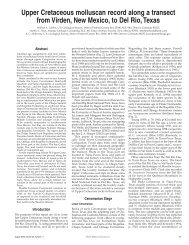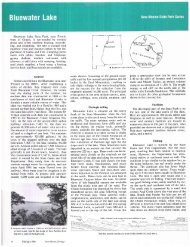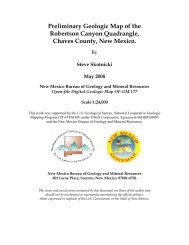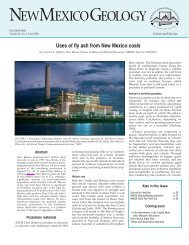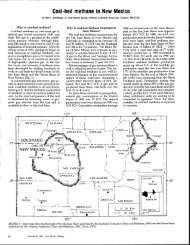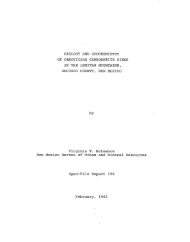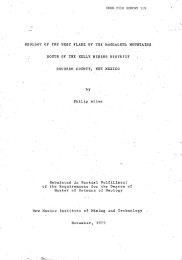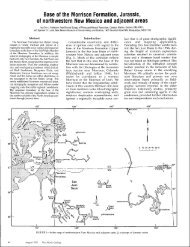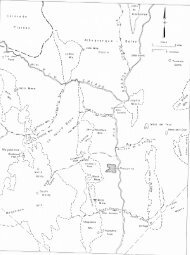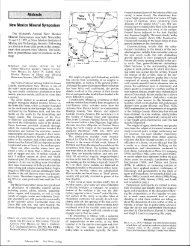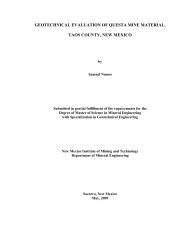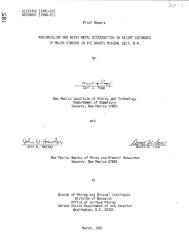- Page 1 and 2: A Preliminary Mineral-Resource Pote
- Page 3 and 4: ABSTFlACT A preliminary mineral-res
- Page 5 and 6: VOLUME I Abstract Introduction Purp
- Page 7 and 8: 1. 2. 3. 4. 5. 6. 7. 8. 9. 10. 11.
- Page 9 and 10: 4. 5. 6. 7. 8. 9. 10. 11. 12. 13. 1
- Page 11 and 12: 41. Comparison of average price of
- Page 13 and 14: 88. 89. INDl JSTRIAL MATERIALS MAPS
- Page 15 and 16: .. . . .. . I. . . .. . . . - 0 5 m
- Page 17 and 18: I I ,I ’ Figure 2. 1:100,000 scal
- Page 19 and 20: . .. 0 -I 0 -I -I 0 3 3 3 a I
- Page 21 and 22: mapping at a scale of 1:24,000 may
- Page 23: e 0
- Page 27 and 28: PHYSIOGRAPHY AND GEOMGY (by V. T. M
- Page 29 and 30: 6 v) C I
- Page 32 and 33: L JJ Figure 9. Time-stratigraphic n
- Page 34 and 35: County and thin to the east and sou
- Page 36 and 37: I . PENNSYLVANIAN 1 PERMIAN Magdale
- Page 38 and 39: (Permian). The Rico Formation consi
- Page 40 and 41: Mesozoic Stratigraphy (by V. T. McL
- Page 42 and 43: actual depositional environment of
- Page 44 and 45: sw Son &on Countv EXPLANATION FT Cl
- Page 46 and 47: lesser amounts of brown carbonaceou
- Page 48 and 49: numerous beds of bentonite. The ben
- Page 52: WLE 2 - Summary of production of va
- Page 57 and 58: DESCRIPTION OF KNOWN MINERAL DEPOSI
- Page 59 and 60: a P i :
- Page 63: N 0
- Page 67 and 68: formally designated pools is summar
- Page 69 and 70: the oil produced from San Juan Coun
- Page 71 and 72: each sandstones that are sealed by
- Page 73 and 74: Chacra pools have either stratigrap
- Page 75 and 76: and gas can be produced. Reservoirs
- Page 77 and 78: shale, siltstone, and fine-grained
- Page 79 and 80: Fig. 22). Nine Pennsylvanian oil po
- Page 81 and 82: ~ . .- .. , Figure 23. Tectonic eie
- Page 83 and 84: Defiance monoclines. Structural rel
- Page 85 and 86: section that might have petroleum p
- Page 87 and 88: subjected to high heat flows associ
- Page 89 and 90: pool (Fig. 19). The Point Lookout c
- Page 91 and 92: target in the San Juan County part
- Page 93 and 94: abandoned Tom pool (Fig. 22). The M
- Page 95 and 96: nonproductive areas. Reservoirs may
- Page 97 and 98: productive petroleum pools is relat
- Page 99 and 100: Possible traps on the Defiance upli
- Page 101 and 102:
States, any accumulations of commer
- Page 104 and 105:
Table 6 - coal production In Sa" Ju
- Page 106 and 107:
Table 8 - Production (short tons) o
- Page 108 and 109:
Table 10. Coal Reserves for San Jua
- Page 110 and 111:
Table 11 (contfd) BarLer Prox. Mois
- Page 112 and 113:
HI5356 T. 311 NI, R. 15 H., BOC 2 ~
- Page 114 and 115:
east (Beaumont, 1971). The southern
- Page 116 and 117:
patterns, drill hole data, and mini
- Page 118 and 119:
operation in 1963, supplying coal t
- Page 120 and 121:
thickness of 6 ft per bed, are pres
- Page 122 and 123:
cuestas dissected by sandy arroyos
- Page 124 and 125:
in San Juan County are the Barker,
- Page 126 and 127:
an area of 140 sq mi. The Hogback m
- Page 128 and 129:
southeast. Major faults are not app
- Page 130 and 131:
The development potential for the N
- Page 132 and 133:
General DescriDtion--Several oil an
- Page 134 and 135:
thickness categories of 2.5, 5, and
- Page 136 and 137:
Table 15 - ursnlum production by co
- Page 138 and 139:
figure^ 26. 10 '0 10 20 30 40 ml b-
- Page 140 and 141:
however, only one property produced
- Page 142 and 143:
TABLE 17 - Uranium production by di
- Page 144 and 145:
(Scarborough, 1981). Chuska Subdist
- Page 146 and 147:
Table 18 - Chemical analyses of ura
- Page 148 and 149:
marginal-marine environment (Mickle
- Page 150 and 151:
Lookout Sandstone in 1954. Many of
- Page 152 and 153:
Geothermal Resources (by V. T. McLe
- Page 154 and 155:
Deposit !rypes Metals (by V. T. McL
- Page 156 and 157:
Geoloap-Vanadium occurs in most of
- Page 158 and 159:
found in the area (Allen, 1951). Th
- Page 160 and 161:
metallic materials have an inherent
- Page 162 and 163:
a place-value basis. Of the materia
- Page 164 and 165:
. . . . ... . I . .. .. . . . ,. .
- Page 166 and 167:
unique specifications that must be
- Page 168 and 169:
TABLE 24. Carbon dioxide content of
- Page 170 and 171:
._ 6
- Page 172 and 173:
with as little as 10-20% C02 could
- Page 174 and 175:
(Fig. 30). The Four Corners platfor
- Page 176 and 177:
Triassic, Permian, and Pennsylvania
- Page 178 and 179:
forms a thixotropic gel in water. T
- Page 180 and 181:
quality of a particular shale. Pote
- Page 182 and 183:
TABLE 26 - Currently exploited and
- Page 184 and 185:
throughout the county, the potentia
- Page 186 and 187:
0 0
- Page 188 and 189:
stones have been used in buildings
- Page 190 and 191:
potential of stone near population
- Page 192:
P -N-
- Page 196 and 197:
TABLE 30 - Helium content of gases
- Page 198 and 199:
TABLE 31 (cont'd) 0 erator, Locatio
- Page 200 and 201:
igneous intrusives that de-gas as t
- Page 202 and 203:
moderate potential. The Four Corner
- Page 204 and 205:
as a discrete tectonic element. Cen
- Page 206 and 207:
section of this report. The coal-be
- Page 208 and 209:
temperature range the material expa
- Page 210 and 211:
or less fragmented by violent erupt
- Page 212 and 213:
Some discrepancy regarding the outc
- Page 214:
approximately eight square miles in
- Page 217 and 218:
I800 1900 2000 2100 2200 Ternperotu
- Page 219 and 220:
material for lime (Boynton and Guts
- Page 221 and 222:
sandy, limestone with some sandy sh
- Page 223 and 224:
. Z
- Page 225 and 226:
tests, which are performed followin
- Page 227 and 228:
0 m x m a e m
- Page 229 and 230:
.. 3.5 3 .O 2.5 2.0 I .5 I .o 0 -5
- Page 231 and 232:
Table 36 - Chemical analyses of raw
- Page 233 and 234:
economic activity (Field, 1972). Su
- Page 235 and 236:
it as a generally unwanted byproduc
- Page 237 and 238:
SUMMARY As is true with all prelimi
- Page 239 and 240:
9) RECOMMENDATIONS Any areas with a
- Page 241 and 242:
REFERENCES Albrethsen, H., Jr., and
- Page 243 and 244:
Barker, J. M., Campbell, F., Evelet
- Page 245 and 246:
Broderick, G. N., 1965, Sulfur: New
- Page 247 and 248:
Chenoweth, W. L., 1957, Radioactive
- Page 249 and 250:
Dugan, T., and Fagrelius, K., 1978b
- Page 251 and 252:
Field, C. W., 1972, Sulfur--element
- Page 253 and 254:
Gruner, J. W., and Smith, D. K., Jr
- Page 255 and 256:
Hornbeck, J. M., 1978, Flora Vista
- Page 257 and 258:
Lease, R. C., 1971a, Hogback upper
- Page 259 and 260:
Matheny, M. L., and Matheny, J. P.,
- Page 261 and 262:
McLemore, V. T., Broadhead, R. F.,
- Page 263 and 264:
Nickelson, H. B., 1988, One hundred
- Page 265 and 266:
Peterson, J. A., Loleit, A. J., Spe
- Page 267 and 268:
Riggs, E. A., 1983b, Crouch Mesa Fr
- Page 269 and 270:
Shomaker, J. W., 1971c, Mesa Verde,
- Page 271 and 272:
Strobell, J. D., Jr., O'Sullivan, R
- Page 273 and 274:
Weide, D. L., Schneider, G. B., Myt
- Page 275 and 276:
1: Occurrence number refers to the
- Page 277 and 278:
FIGURE i-1 - Numbering system used
- Page 279 and 280:
1. NP 2. HN Cunningham Permits 3. 1
- Page 281 and 282:
1. NP 2. Kin-Ark Corporation Projec
- Page 283 and 284:
I. 29N15W04441 2. Christiansen-Blac
- Page 285 and 286:
1. 30N15W16331 2. Walker Mine 3. NE
- Page 287 and 288:
1. 32NiZW18332 2. Unknown Mine 3. N
- Page 289 and 290:
1. 32N13W15443 2. Morgan Mine 3. SW
- Page 291 and 292:
1. 2. Hagback Nos. 3 and 4 Mines 3.
- Page 293 and 294:
I. 2. Hogback No. 9 Mine 3. 1/4 SEC
- Page 295 and 296:
1. NP 2. Hogback No. 13 Mine 3. NW
- Page 297 and 298:
1: 2: 3: 4: 5: 6: 7: 8: 9: 10: 12:
- Page 299 and 300:
1: 2: 3: 4: 5: 6: 7: 8: 9: 10 : 12:
- Page 301 and 302:
1: 2: 3: 4: 5: 6: 7: 8: 9: 10: 12:
- Page 303 and 304:
1: 2: 3: 4: 1: 2: 3: 4: 5: 6: 7: 8:
- Page 305 and 306:
1: 2: 3: 4: 5: 6: 7: 8: 9: 10: 12:
- Page 307 and 308:
1: 2: 3: 4: 5: 6: 7: 8: 9: 10: 12 :
- Page 309 and 310:
1: 2: 3: 4: 5: 6: 7: 8: 9: 10: 12 :
- Page 311 and 312:
1: 2: 3: 4: 5: 6: 7: 8: 9: 10 : 12
- Page 313 and 314:
1: 2: 3: 4: 5: 6: 7: 8: 9: 10: 11:
- Page 315 and 316:
1: 2: 3: 4: 5: 6: 7: 8: 9: 10: 12:
- Page 317 and 318:
1: 2: 3: 4: 5: 6: 7: 8: 9: 10: 11 :
- Page 319 and 320:
1: 2: 3: 4: 5: 6: 7: 8: 9: 10: 11 :
- Page 321 and 322:
1: 2: 3: 4: 5: 6: 7: 8: 9: 10: 11 :
- Page 323 and 324:
1: 29N.21W.26.323 2: Horse Mesa Sou
- Page 325 and 326:
1: 2: 3: 4: 5: 6: 7: 8: 9: 10 : 11:
- Page 327 and 328:
1: 2: 3: 4: 5: 6: 7: 8: 9: 10: 12 :
- Page 329 and 330:
1: 2: 3: 4: 5: 6: 7: 8: 9: 10: 12 :
- Page 331 and 332:
1: 2: 3: 4: 5: 6: 7: 8: 9: 10: 11 :
- Page 333 and 334:
1: 2: 3: 4: 5: 6: 7: 8: 9: 10: 11 :
- Page 335 and 336:
1: 2: 3: 4: 5: 6: 7: 8: 9: 10: 12 :
- Page 337 and 338:
1: 2: 3: 4: 5: 6: 7: 8: 9: 10: 11:
- Page 339 and 340:
SAN JUAN COUNTY INDUSTRIAL MINERALS
- Page 341 and 342:
1: 22N.12W.6.340 2: Materials Pit 3
- Page 343 and 344:
1: 2: 3: 4: 6: 7: 9: 10: 12 : 1: 2:
- Page 345 and 346:
1: 2: 3: 4: 6: 7: 9: 10: 12 : 24N.9
- Page 347 and 348:
1: 2: 3: 4: 6: 7: 9: 10: 12 : 26N.l
- Page 349 and 350:
1: 2: 3: 4: 6: 7: 9: 10 : 12 : 1: 2
- Page 351 and 352:
1: 27N.13W.4.110 3: NW1/4 4 T27N R1
- Page 353 and 354:
1: 2: 3: 4: 6: 1: 2: 3: 4: 6: 7: 8:
- Page 355 and 356:
1: 29N.lOW.35.230 3: W1/2 SW1/4 NE1
- Page 357 and 358:
1: 2: 3: 4: 6: 7: 9: 10 : 12 : 1: 2
- Page 359 and 360:
1: 2: 3: 4: 6: 7: 9: 10 : 12 : 1: 2
- Page 361 and 362:
1: 2: 3: 4: 6: 7: 9: 12 : 29N. 15W.
- Page 363 and 364:
1: 29N.16W.27.300 3: SW 1/4 27 T29N
- Page 365 and 366:
1: 2: 3: 4: 7: 8: 9: 10 : 12 : 1: 2
- Page 367 and 368:
1: 30N.12W.16.221 3: NW 1/4 NE 1/4
- Page 369 and 370:
1: 2: 3: 4: 6: 7: 9: 10 : 12 : 1: 2
- Page 371 and 372:
1: 31N.10@.29.100 2: Gravel Pit 3:
- Page 373 and 374:
1: 2: 3: 4: 6: 9: 10 : 11: 12 : 1:
- Page 375 and 376:
1: 2: 3: 4: 6: 7: 9: 10: 12 : 1: 2:
- Page 377 and 378:
1: 2: 3: 4: 6: 7: 9: 12 : 32N.13W.2
- Page 379 and 380:
Abbreviations used in Table 1. D&A,
- Page 381 and 382:
w e PR M. 3 M. Isaee SDlUlern mien
- Page 383 and 384:
n. L. mu et al. 205 nu, 200 IWL 11/
- Page 385 and 386:
shell Oil a. No. lHayer No. 2Hayero
- Page 387 and 388:
No. 2 ckel Dqm pmil. 0. llM) FSL. 9
- Page 389 and 390:
ccd creek D3v. 1720 Et&, 1Mo F& No.
- Page 391 and 392:
- S W l M Oil h Gas 1650 ESL, 990 p
- Page 393 and 394:
2-16
- Page 395 and 396:
m e Oil m. 1980 RIL, 660 F& 9/61 Dh
- Page 397 and 398:
Mia J. Little 6 330 Ra, 2310 FA E.
- Page 399 and 400:
Alan J. Antmil 1650 FSL, 1650 €%
- Page 401 and 402:
smray HiB-CcntImnt 1980 rsL, 1980 E
- Page 403 and 404:
ulicn Oil 6 HFning sE41 No. 2 Pine
- Page 405 and 406:
Pictured oil No. 1 E M i n miam oil
- Page 407 and 408:
No. 1 €tu- ' 12-m15w Great Heetem
- Page 409 and 410:
Fan Alaei- Pet. 790 ML, 990 na. M.
- Page 411 and 412:
miweal Oil corp. e41 m, 764 m 3/59
- Page 413 and 414:
W. R. Hebb EWMI No. 1 state 6-3Ui-l
- Page 415 and 416:
J. No. 1-A J. Zzmd3 M. 3 2310 FSL,
- Page 417 and 418:
Ludlle Pipkin i€~24 E%l, 1699 FEL
- Page 419 and 420:
milling 6 CXiIq 700 m, 3M Em 3/61 D
- Page 421 and 422:
E. R mchardsol M. 2 Pearl 660 FSL,
- Page 423 and 424:
Wrrell h mxk3 2310 ESL, 2310 FE. No
- Page 425 and 426:
1 BNDaAllaerspl m. 6 mlta oil cv. m
- Page 427 and 428:
2-50
- Page 429 and 430:
Em Amrim Pet. 1650 RIL, 1650 EWL 9/
- Page 431 and 432:
British Aw3Iican 1980 Em, 1980 m 11
- Page 433 and 434:
8. R mt. 330 m, 330 EFL 4/85 DLA 3,
- Page 435 and 436:
POOL NAME: Kiffen Nacimiento Gas Po
- Page 437 and 438:
POOL NAME: Aztec Farmington Gas Poo
- Page 439 and 440:
POOL NAME: Bloomfield Farmington Oi
- Page 441 and 442:
POOL NAME: Kutz Farmington Gas Pool
- Page 443 and 444:
POOL NAME: Oswell Farmington Oil Po
- Page 445 and 446:
POOL NAME: Aztec Fruitland (gas) LO
- Page 447 and 448:
POOL m: Blanco Fruitland Gas Pool L
- Page 449 and 450:
POOL HAME: Conner Fruitland Gas Poo
- Page 451 and 452:
POOL NAME: Farmer Fruitland Gas Poo
- Page 453 and 454:
POOL NAME: Gallegos Fruitland Gas P
- Page 455 and 456:
POOL NAME: Glades Fruitland Gas Poo
- Page 457 and 458:
POOL NAME: Kutz Fruitland Gas Pool
- Page 459 and 460:
POOL NAME: North Los PiEos Fruitlan
- Page 461 and 462:
POOL NAME: Pifion Fruitland Gas Poo
- Page 463 and 464:
POOL NAME: Pump Mesa Fruitland Gas
- Page 465 and 466:
POOL NAME: Albino Pictured Cliffs G
- Page 467 and 468:
POOL NAME: Ballard Pictured Cliffs
- Page 469 and 470:
POOL NAME: South Blanc0 Pictured Cl
- Page 471 and 472:
POOL NAME: South Gallegos Fruitland
- Page 473 and 474:
POOL NAME: Harper Hill Fruitland-Pi
- Page 475 and 476:
POOL NAME: West Kutz Pictured Cliff
- Page 477 and 478:
POOL NAME: Ojo Fruitland-Pictured C
- Page 479 and 480:
POOL NAME: Twin Mounds Pictured Cli
- Page 481 and 482:
POOL NAME: Blanco Mesaverde Gas Poo
- Page 483 and 484:
POOL NAME: Cuervo Mesaverde Oil Poo
- Page 485 and 486:
POOL NAME: Nenahnezad Mesaverde Oil
- Page 487 and 488:
POOL NAME: Twin Mounds Mesaverde Ga
- Page 489 and 490:
POOL NAME: Navajo City Chacra Gas P
- Page 491 and 492:
POOL NAME: Alamito Gallup Oil Pool
- Page 493 and 494:
POOL NAME: Amarillo Gallup Oil Pool
- Page 495 and 496:
POOL NAME: Armenta Gallup Oil Pool
- Page 497 and 498:
POOL NAME: Calloway Gallup Gas Pool
- Page 499 and 500:
POOL NAME: Cuervo Gallup Oil Pool L
- Page 501 and 502:
POOL NAME: Eagle Gallup Gas Pool LO
- Page 503 and 504:
POOL NAME: Flora Vista Gallup Gas P
- Page 505 and 506:
POOL NAME: Horseshoe Gallup Oil Poo
- Page 507 and 508:
POOL NAME: Knickerbocker Buttes Gal
- Page 509 and 510:
POOL NAME: La Plata Gallup Oil Pool
- Page 511 and 512:
POOL NAME: Many Rocks Gallup Oil Po
- Page 513 and 514:
POOL NAME: McDermott Gallup Gas Poo
- Page 515 and 516:
POOL NAME: Mesa Gallup Oil Pool LOC
- Page 517 and 518:
POOL NAME: Ojo Gallup Gas Pool LOCA
- Page 519 and 520:
POOL NAME: Rattlesnake Gallup Oil P
- Page 521 and 522:
POOL NAME: North Shiprock Gallup Ga
- Page 523 and 524:
POOL NAME: Totah Gallup Oil Pool LO
- Page 525 and 526:
POOL NAME: Verde Gallup Oil Pool LO
- Page 527 and 528:
POOL NAME: Barker Creek Dakota Gas
- Page 529 and 530:
POOL NAME: Dufers Point Gallup-Dako
- Page 531 and 532:
POOL NAME: Rattlesnake Dakota Oil P
- Page 533 and 534:
POOL NAME: North Shiprock Dakota Oi
- Page 535 and 536:
POOL NAME: Snake Eyes Dakota Gas Po
- Page 537 and 538:
POOL NAME: Straight Canyon Dakota G
- Page 539 and 540:
POOL NAME: Ute Dome Dakota Gas Pool
- Page 541 and 542:
POOL NAME: Leggs Entrada Oil Pool L
- Page 543 and 544:
POOL NAME: Barker Creek Paradox Gas
- Page 545 and 546:
POOL NAME: Blue Hill Paradox Gas Po
- Page 547 and 548:
POOL NAME: Cone Paradox Oil Pool LO
- Page 549 and 550:
POOL NAME: Hogback Pennsylvanian Oi
- Page 551 and 552:
WOL NAME: Pajarito Pennsylvanian D
- Page 553 and 554:
POOL NAME: Table Mesa Pennsylvanian
- Page 555 and 556:
POOL NAME: Ute Dome Paradox Gas Poo
- Page 557 and 558:
POOL NAME: Hogback Mississippian Oi
- Page 559 and 560:
POOL NAME: North Tocito Dome Missis
- Page 561 and 562:
POOL NAME: Tom Devonian Oil Pool LO
- Page 563 and 564:
Termem Oil m. 6-3m. 5/81 2,903 2,69
- Page 565 and 566:
mEL5 6 (mt'd) Wrator, m t i m mte T
- Page 567 and 568:
usan prm~cric~ mrp. 27-2m-w. No. 1
- Page 569 and 570:
T m Oil 00. X-29N-RI. No. 1 Ramner
- Page 571 and 572:
Tenncm oil 00. 162&1ai, No. 2 bum?n
- Page 573 and 574:
!' COUNTY and QUAD - County and qua
- Page 575 and 576:
SAMPLE NO. 2925O(usbm 569) DONE FOR
- Page 577 and 578:
SAMPLE NO. 2464(usbm 569) DONE FOR
- Page 579 and 580:
SAMPLE NO. dl94019 DONE FOR usqs of
- Page 581 and 582:
SAMPLE NO. dl94025 DONE FOR usqs of
- Page 583 and 584:
SAMPLE NO. ~~g~(d)d190720,b DONE FO
- Page 585 and 586:
SAMPLE NO. b-61247 DONE FOR usbm SA
- Page 587 and 588:
SAMPLE NO. #p-78-18-c DONE FOR cima
- Page 589 and 590:
SmLE NO. #p-78-18-c DONE FOR cimarr
- Page 591 and 592:
SAMPLE NO. dh #78-19-c DONE FOR cim
- Page 593 and 594:
SAMPLE NO. dh #78-22-c DONE FOR cim
- Page 595 and 596:
SAMPLE NO. #78-19-c DONE FOR cimarr
- Page 597 and 598:
SAMPLE NO. 78-28 DONE FOR cimarron
- Page 599 and 600:
SAMPLE NO. #78-19-c #53 DONE FOR ci
- Page 601 and 602:
SAMPLE NO. b-7-80-205-1 WNE FOR wes
- Page 603 and 604:
SAMPLE NO. b-7-80-212-3 DONE FOR we
- Page 605 and 606:
SAMPLE NO. #38 78-28 DONE FOR cimar
- Page 607 and 608:
SAMPLE NO. #23 78-13 WNE FOR cimarr
- Page 609 and 610:
SAMPLE NO. #8 78-3 DONE FOR cimarro
- Page 611 and 612:
SAMPLE NO. 39-78-28 DONE FOR cimarr
- Page 613 and 614:
SAMPLE NO. 8-78-3 DONE FOR charron
- Page 615 and 616:
SAMPLE NO. 33-78-12 DONE FOR cimarr
- Page 617 and 618:
SAMPLE NO. 9-1 DONE FOR cimarron co
- Page 619 and 620:
SAMPLE NO. 1-78-2 DONE FOR cimarron
- Page 621 and 622:
SAMPLE NO. j-63220 DONE FOR mem 25
- Page 623 and 624:
SAMPLE NO. 5 DONE FOR ma25 SAMPLE L
- Page 625 and 626:
SAMPLE NO. 14 DONE FOR mem 25 SAMPL
- Page 627 and 628:
SAMPLE NO. 72-4260 DONE FOR c-134 c
- Page 629 and 630:
SAMPLE NO. 50f DONE FOR western coa
- Page 631 and 632:
SAMPLE NO. p-21-h DONE FOR san juan
- Page 633 and 634:
SAMPLE NO. ui-10-142 DONE FOR Utah
- Page 635 and 636:
SAMPLE NO. Ui-16-183 DONE FOR utah
- Page 637 and 638:
SAMPLE NO. ui-17-132 DONE FOR Utah
- Page 639 and 640:
SAMPLE NO. ui-19-94 DONE FOR Utah i
- Page 641 and 642:
SAMPLE NO. ui-20-105 DONE FOR Utah
- Page 643 and 644:
SAMPLE NO. ui-2-133 WNE FOR utah in
- Page 645 and 646:
SAMPLE NO. ui-7-123 DONE FOR Utah i
- Page 647 and 648:
SAMPLE NO. ui-9-80 DONE FOR Utah in
- Page 649 and 650:
SAMPLE NO. ui-12-75 DONE FOR Utah i
- Page 651 and 652:
SAMPLE NO. Ui-13-109 DONE FOR Utah
- Page 653 and 654:
SAMPLE NO. ui-14-133 DONE FOR Utah
- Page 655 and 656:
SAMPLE NO. ui-14-193 DONE FOR Utah
- Page 657 and 658:
SAMPLE NO. ui-15-179 DONE FOR Utah
- Page 659 and 660:
SAMPLE NO. ui-21-75 DONE FOR Utah i
- Page 661 and 662:
SAMPLE NO. ui-23-170 DONE FOR SAMPL
- Page 663 and 664:
SAMPLE NO. h-19885 DONE FOR SAMPLE
- Page 665 and 666:
SAMPLE NO. 23004(usbm 569) DONE FOR
- Page 667 and 668:
SAMPLE NO. 144 DONE FOR san juan SA
- Page 669 and 670:
I' i' .. .(. I .: .. Appendix 6 Coa
- Page 671 and 672:
APPENDIX Coal Resource Data for San
- Page 673 and 674:
WELL NUMBER sj 401 COUNTY san juan
- Page 675 and 676:
WELL NUMBER sj 403 COUNTY san juan
- Page 677 and 678:
WELL NUMBER sj 405 COUNTY san juan
- Page 679 and 680:
WELL NUMBER sj 407 COUNTY san juan
- Page 681 and 682:
WELL NUMBER usgs-3 COUNTY san juan
- Page 683 and 684:
WELL NUMBER hz 6 COUNTY san juan QU
- Page 685 and 686:
WELL NUMBER 8815-108 COUNTY san jua
- Page 687 and 688:
WELL NUMBER 8960-100 COUNTY san jua
- Page 689 and 690:
WELL NUMBER 12278-69 COUNTY rio arr
- Page 691 and 692:
WELL NUMBER p79 COUNTY san juan QUA
- Page 693 and 694:
WELL NUMBER 179 COUNTY san juan QUA
- Page 695 and 696:
WELL NUMBER 18-13-13 COUNTY san jua
- Page 697 and 698:
WELL NUMBER federal gas no. 1 COUNT
- Page 699 and 700:
WELL NUMBER sju 32-9-63 COUNTY san
- Page 701 and 702:
WELL NUMBER allison # 16 COUNTY rio
- Page 703 and 704:
WELL NUMBER QUADRANGLE allison # 17
- Page 705 and 706:
WELL NUMBER mesaunit#32-4#1-29 COUN
- Page 707 and 708:
WELL NUMBER fed lease no. 1 COUNTY
- Page 709 and 710:
WELL NUMBER tl-27-1 COUNTY san juan
- Page 711 and 712:
WELL NUMBER usgs 6 COUNTY san juan
- Page 713 and 714:
WELL NUMBER dh-9k COUNTY san juan Q
- Page 715 and 716:
WELL NUMBER QUADRANGLE dh-1 COUNTY
- Page 717 and 718:
WELL NUMBER tl-7-2 COUNTY san juan
- Page 719 and 720:
WELL NUMBER tl-8-1 COUNTY san juan
- Page 721 and 722:
WELL NUMBER tl-8-2 COUNTY san juan
- Page 723 and 724:
WELL NUMBER amw 6-1 COUNTY san juan
- Page 725 and 726:
WELL NUMBER army 6-2 COUNTY san jua
- Page 727 and 728:
WELL NUMBER dh 2k COUNTY san juan Q
- Page 729 and 730:
WELL NUMBER dh 4k COUNTY san juan Q
- Page 731 and 732:
WELL NUMBER dh 6k COUNTY san juan Q
- Page 733 and 734:
WELL NUMBER USgS 8 COUNTY san juan
- Page 735 and 736:
WELL NUMBER p-22 COUNTY san juan QU
- Page 737 and 738:
WELL NUMBER p-28 COUNTY san juan QU
- Page 739 and 740:
WELL NUMBER p-30 COUNTY san juan QU
- Page 741 and 742:
WELL NUMBER p-32 COUNTY san juan QU
- Page 743 and 744:
WELZ, NUMBER p-36 COUNTY san juan Q
- Page 745 and 746:
WELL NUMBER 1-26 COUNTY san juan QU
- Page 747 and 748:
WELL NUMBER r-28d COUNTY san juan Q
- Page 749 and 750:
WET& NUMBER 32n13w28.1 COUNTY san j
- Page 751 and 752:
WELL NUMBER 22nlOw17.1 COUNTY san j
- Page 753 and 754:
WELL NUPlBER 23nllw19.1 COUNTY san
- Page 755 and 756:
WELL NUMBER 22n9w29.1 COUNTY san ju
- Page 757 and 758:
WELL NUMBER 23n12w6 COUNTY san juan
- Page 759 and 760:
WELL NUMBER b-1 COUNTY san juan QUA
- Page 761 and 762:
WELL NUMBER b-2 COUNTY san juan QUA
- Page 763 and 764:
WELL NUMBER b-3 COUNTY san juan QUA
- Page 765 and 766:
WEZL NUMBER b-4 COUNTY san juan QUA
- Page 767 and 768:
WELL NUMBER b-5 COUNTY san juan QUA
- Page 769 and 770:
WELTJ NUMBER b-18 COUNTY san juan Q
- Page 771 and 772:
WELL NUMBER b-19 COUNTY san juan QU
- Page 773 and 774:
WEU NUMBER b-21 COUNTY san juan QUA
- Page 775 and 776:
WELL NUMBER b-22 COUNTY san juan QU
- Page 777 and 778:
WELL NUMBER b-23 COUNTY san juan QU
- Page 779 and 780:
WELL NUMBER a-4 COUNTY san juan QUA
- Page 781 and 782:
WELL NUMBER a-11 COUNTY san juan QU
- Page 783 and 784:
WELL NUMBER a-16 COUNTY san juan QU
- Page 785 and 786:
WELL NUMBER a-13 COUNTY san juan QU
- Page 787 and 788:
WELL NUMBER a-14 COUNTY san juan QU
- Page 789 and 790:
WELL NUMBER a-22 COUNTY san juan QU
- Page 791 and 792:
WELL NUMBER a-24 COUNTY san juan QU
- Page 793 and 794:
WELL NUMBER sj 41 COUNTY san juan Q
- Page 795 and 796:
WELL NUMBER 3114-30-3 COUNTY san ju
- Page 797 and 798:
WELL NUMBER sj 40 COUNTY san juan Q
- Page 799 and 800:
WELL NUMBER sj 184 COUNTY san juan
- Page 801 and 802:
WELL NUMBER navajo tribe 6213 COUNT
- Page 803 and 804:
WELL NTJMBER hz 40 COUNTY san juan
- Page 805 and 806:
WELL NUMBER hz 43 COUNTY san juan Q
- Page 807 and 808:
WELL NUMBER hz 25 COUNTY san juan Q
- Page 809 and 810:
WELL NUMBER 25430 COUNTY san juan Q
- Page 811 and 812:
WELL NUMBER 25635 COUNTY san juan Q
- Page 813 and 814:
WELL NUMBER 20835 COUNTY san juan Q
- Page 815 and 816:
WELL NUMBER 20677 COUNTY san juan Q
- Page 817 and 818:
WELT, NUMBER 25753 COUNTY san juan
- Page 819 and 820:
WELL NUMBER 14238-61 COUNTY san jua
- Page 821 and 822:
WELL NUMBER 9394-71 COUNTY rio arri
- Page 823 and 824:
WELL NUMBER 8815-108 COUNTY san jua
- Page 825 and 826:
WELL NUMBER 17877-194 COUNTY rio ar
- Page 827 and 828:
WELL NUMBER 22382-163 COUNTY rio ar
- Page 829 and 830:
WELL NUMBER 20419 COUNTY san juan Q
- Page 831 and 832:
WELL NUMBER 11327 COUNTY san juan Q
- Page 833 and 834:
WELL NUMBEX 15796 COUNTY san juan Q
- Page 835 and 836:
WEJX NUMBER 9460 COUNTY san juan QU
- Page 837 and 838:
WELL NUMBER 18775 COUNTY san juan Q
- Page 839 and 840:
WELL NUMBER 20504 COUNTY san juan Q
- Page 841 and 842:
WELL NUMBER 11781-225 COUNTY rio ar
- Page 843 and 844:
WELL NUMBER 26014 COUNTY san juan Q
- Page 845 and 846:
WELL NUMBER 25502 COUNTY san juan Q
- Page 847 and 848:
WELL NUMBER 25875 COUNTY san juan Q
- Page 849 and 850:
WELL NUMBER 25480 COUNTY san juan Q
- Page 851 and 852:
WELL NUMBER 14501 COUNTY san juan Q
- Page 853 and 854:
WELL NUMBER 22167 COUNTY san juan Q
- Page 855 and 856:
WELL NUMBER 25729 QUADRANGLE espino
- Page 857 and 858:
WELL NUMBER 25684 COUNTY san juan O


